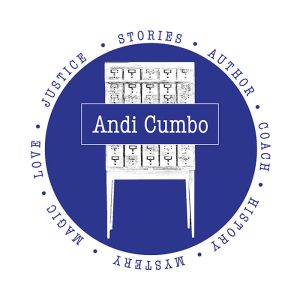Ginger Moran is one of those writers I’m so grateful I know because she sees the world of words much like I do. Today, she’s sharing her wisdom about how to write well about place in our work. Be sure to pick up her novels through the affiliate links (I get a small commission if you buy through them) at the end of the post. Now, off to study place.
When I teach novel and memoir writing, I use a method that I call by the (very clever) name, “The Four P’s.”
After getting a Ph.D. in creative writing, teaching it for many years at the university level, and writing seven books of my own, I have managed to distill just about all I know down into a simple system.
A good story is made up of four major elements:
Problem
People
Place
Plot
When I set out to write my latest book, American Queen, I had a problem I wanted to solve: why do people make decisions so often that are bad for them? And I had a vague idea who the people were—a woman and her spy husband. Which led me pretty inevitably to the setting where it would all take place: Washington, DC.
And that set me on a quest.
I call it “Place,” but that is a little bit of a misnomer because it is really about the entire context.
Once you have a problem and you have a point of view, the very next piece of the building block is where, when, and how the story unfolds.
Place is a Big Issue
The important part of this is to remember that the “place”—the context of the story—is as important as the characters. There is a larger context—the historical period, the social/economic/political context, the reason the problem matters—is what connects your story to your reader. If the story is only happening to you, in a context that no one else knows anything about, it is not going to matter to anyone else.
So I teach people to take some time to get clear about their larger context and then about the smaller contexts—the scenes—that, strung together, will make up the story.
The context of the story allows your readers to fully participate in the story as if they were there. If your book were a painting, you would have chosen a subject of the painting—that is the problem, or why you are writing this—and you would have chosen a point of view—that is the eyes through which the problem is being seen—and now you are starting to fill in the surrounding area—all those parts of the story that make the problem and the people meaningful.
Place is really the whole context—where the story is happening, yes, but also the conditions it is happening in.
The Many Moving Parts of Place
There are many moving parts to this:
- The actual location.
- The location in time.
- The social context.
- The economic context.
- What the characters are seeing and feeling.
- And, last but far from least, the weather.
Researching Places
Oh, place! The geography, the history, the culture, the moment, the season, the weather!
In my first novel, The Algebra of Snow, winter is pretty much the antagonist in the book. I loved all the ways I got to play with frozen things there. Along with the math. And I can’t add. So why not write a book about algebra?
I digress.
When I started writing American Queen, I knew it took place in Washington, DC, a city I know a little bit. My mother lived there as a child, my old aunties lived there, and my cousins still are sprinkled around it. We visited a lot.
But that wasn’t what I was after.
I was after upper-level Washington—society, high level politics, high level academics.
My wonderful friend and colleague Ed Hutchison, denizen of DC, and I have had several adventures there now, the first of them being a tour of Georgetown.
Every part of American Queen came from our tour.
We started at Georgetown University and the Economics Department (which bears absolutely no resemblance to the office in the book), stopped by the lovely little Catholic church near the campus, Trinity, and then we had coffee at Dean and Delucca’s. I would return to that area to interview DC party planners via phone, thanks to covid, to get final details of DC party life.
We drove through Georgetown looking at the houses, then walked through sections. We both were knocked over by the giant estate within the confines of the neighborhood—which is dominated by mostly tight, townhouse-driven architecture. And then we both fell in love with a lovely, towered, Victorian on a corner.
And that was that. Agatha’s ambassadorial parents were going to live in the big estate and Agatha and her spy husband in the Victorian.
I just had to find out more about them.
And that led to some pretty big surprises.
The big estate is called Evermay. It belongs to private citizens now, but was once open for public events. Because things on the internet never die, I could see the photographs of the inside. I changed everything around in the book, because fiction. But, boy, was it fun touring virtually through the house.
And then I had the biggest surprise when I found the Victorian. Because I am at heart a nerd and love research, I know how to find the owners of houses (it is a matter of public record). So I thought, gosh, that names sounds familiar, when I found the owner of the big Victorian. So I googled it.
It was Bob Woodward!
If you read the book, you will know the significance of this is that it is a story of the convergence of the dogged inquiry by the main character into political mysteries.
I couldn’t have been happier or more admiring of jolly old synchronicity.
Whoo—eee! Researcher nerd pure gold!
I could see the inside of much of the house in the article (which bears a slight resemblance to the inside of the fictional house).
I couldn’t WAIT to tell Ed and then to dive into writing the scenes, especially the big party scenes that take place at the two houses.
Enjoy the Process of Place
Finding and researching the setting for your book can be both enlightening and entertaining. It can be a real place and it can be all the meanings and metaphors attached to that place, that time, that political situation. And don’t forget the weather!
Here are the points to remember about place:
- Be conscious of your larger context—what is happening in the world: how does this drive your story or create your problem? How does it help your reader connect?
- Use physical detail to give this information to your reader.
- Build each scene carefully, giving rich physical detail to create mood, meaning, and motion forward.
 A published and award-winning writer, teacher, and book mentor, Ginger Moran’s areas of expertise are in nonfiction and fiction writing and editing. She has Bachelor’s and Master’s degrees in English from the University of Virginia and a Ph.D. in Creative Writing from the University of Houston. She has published in salon.com, Oxford American, the Virginia Quarterly Review, among other journals and magazines. Her first novel, The Algebra of Snow, was nominated for a Pushcart Editor’s Choice Award and published in 2012. Her latest, American Queen, is available on Amazon. She works with aspiring writers who want to write great books and can be reached through her website: gingermoran.com
A published and award-winning writer, teacher, and book mentor, Ginger Moran’s areas of expertise are in nonfiction and fiction writing and editing. She has Bachelor’s and Master’s degrees in English from the University of Virginia and a Ph.D. in Creative Writing from the University of Houston. She has published in salon.com, Oxford American, the Virginia Quarterly Review, among other journals and magazines. Her first novel, The Algebra of Snow, was nominated for a Pushcart Editor’s Choice Award and published in 2012. Her latest, American Queen, is available on Amazon. She works with aspiring writers who want to write great books and can be reached through her website: gingermoran.com

